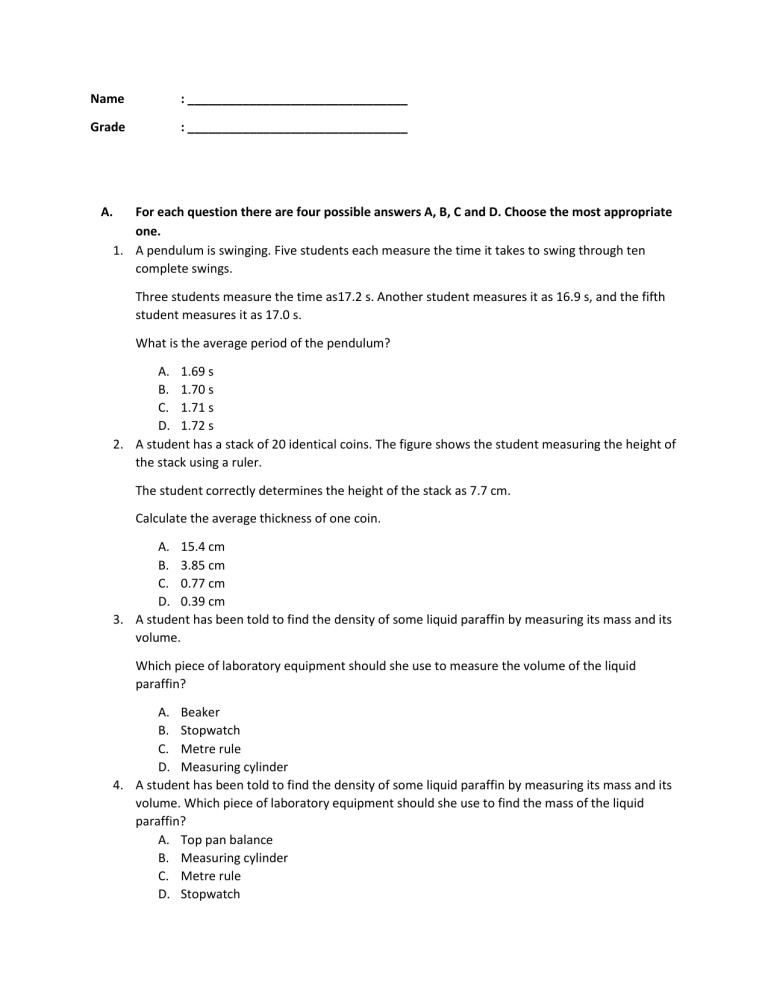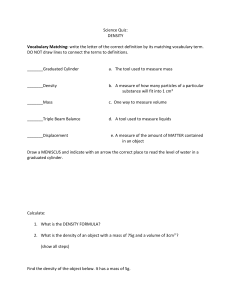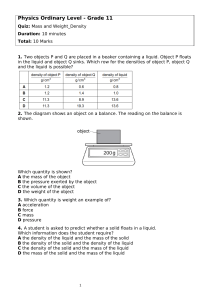
Name : ________________________________ Grade : ________________________________ A. For each question there are four possible answers A, B, C and D. Choose the most appropriate one. 1. A pendulum is swinging. Five students each measure the time it takes to swing through ten complete swings. Three students measure the time as17.2 s. Another student measures it as 16.9 s, and the fifth student measures it as 17.0 s. What is the average period of the pendulum? A. 1.69 s B. 1.70 s C. 1.71 s D. 1.72 s 2. A student has a stack of 20 identical coins. The figure shows the student measuring the height of the stack using a ruler. The student correctly determines the height of the stack as 7.7 cm. Calculate the average thickness of one coin. A. 15.4 cm B. 3.85 cm C. 0.77 cm D. 0.39 cm 3. A student has been told to find the density of some liquid paraffin by measuring its mass and its volume. Which piece of laboratory equipment should she use to measure the volume of the liquid paraffin? A. Beaker B. Stopwatch C. Metre rule D. Measuring cylinder 4. A student has been told to find the density of some liquid paraffin by measuring its mass and its volume. Which piece of laboratory equipment should she use to find the mass of the liquid paraffin? A. Top pan balance B. Measuring cylinder C. Metre rule D. Stopwatch 5. What is the most accurate and precise method to measure the thickness of a coin? A. Use a top pan balance. B. Use a micrometer screw gauge. C. Use a ruler and look at the scale perpendicularly. D. Use the displacement method with water in a measuring cylinder. 6. A mechanical pencil has the density of 3.000 g/cm3. The volume of the pencil is 15.8 cubic centimeters. What is the mass of the pencil? A. 47.4 g B. 50 g C. 0.190 g D. 5.27 g 7. What is the volume of 150 grams of lead if it has a density of 11.3 g/cm3? A. 13.3 g B. 13.3 cm3 C. 0.075 g D. 1695 cm3 8. The diagram shows the height of a stack of identical coins. What is the thickness of one coin? A. 0.20 mm B. 2.0 mm C. 0.24 cm D. 2.0 cm 9. A student is asked to find the volume of a small irregularly-shaped piece of rock. He has the following apparatus available. Which apparatus must the student use to find the volume of the small piece of rock? A. balance and rule B. rule only C. balance and measuring cylinder D. measuring cylinder only 10. Which instrument is used to measure accurately the diameter of a thin metal wire? A. 30 cm ruler B. measuring tape C. metre rule D. micrometer screw gauge 11. Water drips from a tap into a measuring cylinder. The table shows the volume of water in the cylinder every minute for four minutes. What is the average volume of water collected in the cylinder each minute? A. B. C. D. 22 cm3 28 cm3 56 cm3 57 cm3 12. How far did McKenzie travel in the first 3 hours? A. B. C. D. 6.66 km 30 km 60 km 20 km 13. What was McKenzie's average speed for the entire journey? A. B. C. D. 6.25 km/h 12.5 km/h 25 km/h 100 km/h 14. What is happening in this graph from point B to C? 15. 16. 17. 18. A. The object is going down a hill. B. The object is returning to its starting location. C. The object is slowing down. D. The object is staying still. What is happening in the graph from point O to A? A. The object is moving SLOWLY at a constant speed B. The object is moving FAST at a constant speed C. The object is NOT moving D. The object is accelerating What is happening from point D to E? A. The object is accelerating SLOWLY B. The object is accelerating FAST C. The object is decelerating D. The object is NOT moving What is happening in this graph from point A to B? A. The object is accelerating. B. The object is not moving. C. The object is decelerating. D. The object is moving at a constant speed. What is this graph showing? A. B. C. D. Constant Speed Acceleration (speeding up) Deceleration (slowing down) No motion 19. What is this graph showing? A. B. C. D. Constant Speed Acceleration (speeding up) Deceleration (slowing down) No motion 20. What is this graph showing? A. B. C. D. Constant Speed Acceleration (speeding up) Deceleration (slowing down) No motion







